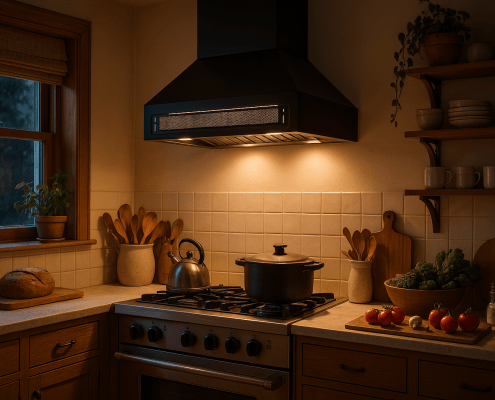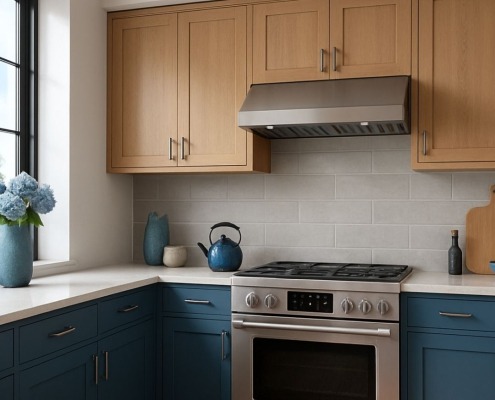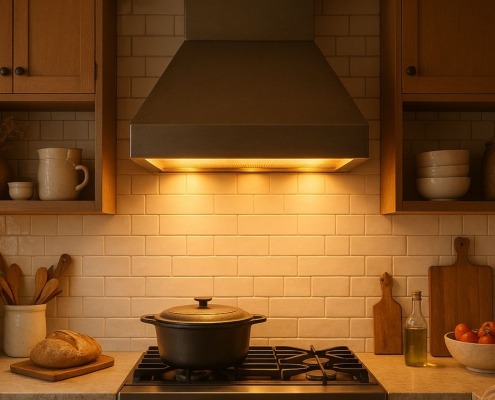Differences between ducted and ductless range hoods
Steven E / Tuesday April 22, 2025
Range hoods are a crucial part of every kitchen, responsible for keeping the air clean and removing cooking smells, grease, and smoke. But when it’s time to pick the right range hood for your kitchen, you face a significant decision: ducted or ductless?
Whether you’re remodeling your kitchen or just thinking about upgrading your range hood, come with us as we look into the distinctions between ducted and ductless range hoods. This way, you can pick the perfect solution for a kitchen that smells fresh and is more enjoyable to cook in.
If you need any replacement parts for your appliance, you can enter your model number at AppliancePartsPros.com to order them. Most orders arrive in just two business days, and we have thousands of free guides to show you how to install your new parts.
The information in this article may not apply to your specific appliance model. We recommend consulting your manufacturer’s documentation or contact us with any questions.
Ducted range hoods
Ducted range hoods offer stronger ventilation and are particularly effective for kitchens with intensive cooking needs. However, the decision to install one should be made considering factors such as installation complexity, cost, space, and home structure. Weighing the advantages against these considerations can help you determine whether a ducted range hood is the right choice for your kitchen.
Ducted range hoods operate by extracting airborne contaminants, such as cooking odors, grease, and smoke, from the kitchen and expelling them outside the building. This is achieved through a system of ducts that connect the hood to an external vent, typically leading to the roof or an exterior wall. The process involves a powerful fan within the range hood that sucks in the contaminated air. The air passing through filters that capture grease and larger particles. The cleaned air then passing through a duct system and being expelled outside.
Ducted range hoods offer several advantages, including:
- Ducted hoods provide superior ventilation by completely removing cooking byproducts from your kitchen.
- They excel at eliminating cooking odors and smoke, ensuring your kitchen remains fresh and comfortable.
- Ducted hoods can run continuously without the need for frequent filter replacement.
- They are the preferred choice for kitchens that experience frequent, high-volume cooking.
While ducted range hoods offer robust ventilation, there are certain limitations and installation considerations to keep in mind:
- Installing ducted range hoods involves routing ductwork through your kitchen, which can be complex and may require professional installation.
- The installation of ducted range hoods is often more expensive due to ductwork and venting requirements.
- Ductwork may require space within your kitchen and affect its overall aesthetics.
- The feasibility of installing a ducted hood may depend on the layout and structure of your home.
Ductless range hoods
Ductless range hoods provide an accessible and versatile solution for kitchen ventilation. Their ease of installation, cost efficiency, and flexibility in placement make them an attractive choice for many kitchens. However, it’s essential to consider their limitations, especially in terms of air recirculation and odor removal, before deciding whether a ductless range hood is the right fit for your specific cooking needs.
Ductless range hoods, also referred to as recirculating or non-vented hoods, operate by capturing airborne contaminants during cooking and filtering them before releasing the cleaned air back into the kitchen. The process involves a powerful fan within the range hood that pulls in cooking byproducts, including odors, grease, and smoke. The contaminated air passing through filters designed to trap and purify these particles. The cleaned air is then recirculated back into the kitchen, free from the impurities captured by the filters.
Ductless range hoods offer several advantages, including:
- They are easier to install than ducted hoods since they don’t require complex ductwork or venting.
- Ductless hoods can be installed virtually anywhere in the kitchen, providing flexibility in their placement.
- They do not require additional space for ductwork, making them suitable for kitchens with limited space.
- Ductless range hoods are typically more budget-friendly in terms of installation costs.
While ductless range hoods offer convenience and versatility, there are specific limitations and installation considerations to take into account:
- Ductless hoods recirculate air back into the kitchen, so they do not entirely remove contaminants but rather filter them.
- While effective at capturing grease particles, ductless hoods may be less efficient at eliminating strong cooking odors and smoke.
- The filters in ductless range hoods require periodic replacement or cleaning, incurring ongoing maintenance costs.
- They are better suited for kitchens with less frequent and lower-volume cooking.
Cost considerations
In choosing between ducted and ductless range hoods, assess your budget and long-term cost considerations. Ducted hoods may involve higher upfront installation costs but potentially lower ongoing expenses. Ductless hoods offer cost savings during installation but require regular filter replacement or cleaning, which can impact your budget over time. Carefully weighing these cost factors will help you make an informed decision that aligns with your financial priorities and kitchen needs.
- Installing ducted range hoods typically involves higher installation costs due to the need for ductwork and, in many cases, professional installation services.
- The cost of ductwork, venting materials, and any necessary alterations to your kitchen’s structure can add to the overall expenses.
- While ducted hoods may be more energy-efficient, the overall cost of operation depends on factors like electricity usage and maintenance.
- Ductless hoods are generally easier and more cost-effective to install, as they do not require ductwork. This can result in significant cost savings, particularly if you choose a DIY installation approach.
- Ductless hoods require ongoing filter maintenance. While the filters themselves are typically less expensive than ductwork, the recurring cost of filter replacement or cleaning should be considered.
- Ductless hoods offer cost savings upfront due to their ease of installation, but the ongoing cost of filter maintenance can accumulate over time, especially for kitchens with frequent cooking activities.
- The energy efficiency of range hoods can also impact your utility bills over time. Ducted hoods may be more energy-efficient since they expel air outside, whereas ductless hoods recirculate air within the kitchen.
- Consider the potential effects on your monthly energy expenses.
Choosing the right range hood for your kitchen
Selecting the right range hood for your kitchen is a decision that should be based on a thoughtful evaluation of your cooking habits, kitchen layout, budget, maintenance preferences, and environmental concerns. By considering these factors, you can make an informed choice that enhances your kitchen’s functionality and air quality, ensuring a more enjoyable cooking experience.
- Start by evaluating your cooking habits and the volume of cooking you typically undertake. Consider whether you frequently cook dishes that produce strong odors, smoke, or excessive grease.
- If your cooking involves frequent high-volume or intense culinary activities, such as deep frying or grilling, a ducted range hood is the better choice due to its superior ventilation and odor elimination capabilities.
- If your cooking is more occasional or involves less intense odors and smoke, a ductless range hood may suffice, providing flexibility in placement and a more budget-friendly installation.
- Examine your kitchen’s layout, available space, and the feasibility of installing ductwork or an external vent.
- If your kitchen is tight on space, a ductless range hood offers versatility and ease of installation without the need for ductwork. It can fit well in kitchens with limited room for ventilation solutions.
- If your kitchen layout allows for ductwork and external venting, a ducted range hood can be seamlessly integrated into your design, providing efficient and unobtrusive ventilation.
- Carefully consider your budget, both for initial installation and long-term expenses.
- If you have a larger budget for installation and prioritize long-term energy efficiency, a ducted range hood is an excellent choice, as it may result in lower ongoing costs.
- If you are budget-conscious and prefer an economical initial installation, a ductless range hood is a cost-effective option. However, be prepared for recurring filter replacement or cleaning expenses.
- If you prefer hassle-free maintenance and are willing to replace or clean filters periodically, a ductless range hood offers ease of maintenance.
- If you seek minimal maintenance and are comfortable with less frequent filter replacement or cleaning, a ducted range hood might be the better choice.
- Ducted range hoods are typically more energy-efficient, as they expel air outside. If you prioritize environmental sustainability, this option may align with your values.
- Ducted hoods offer superior indoor air quality by entirely removing cooking byproducts. If maintaining a clean and fresh kitchen environment is important to you, this option may be more suitable.
Additional information
Thank you for reading! We hope you found this information helpful in understanding range hoods. If you have any other appliance repair needs or projects, don’t hesitate to explore our thousands of free videos and troubleshooting guides available. If you need replacement parts or some extra help with ordering them, grab your model number and head over to AppliancePartsPros.com, where you can chat with a pro, read our DIY blog and more.
Be sure to subscribe to us on YouTube and follow us on Facebook, Twitter and Instagram!
With nearly a decade of experience in providing top-notch customer service regarding appliance parts and repair, Steven enjoys sharing practical advice, troubleshooting tips, and interesting information to help readers stay informed.





